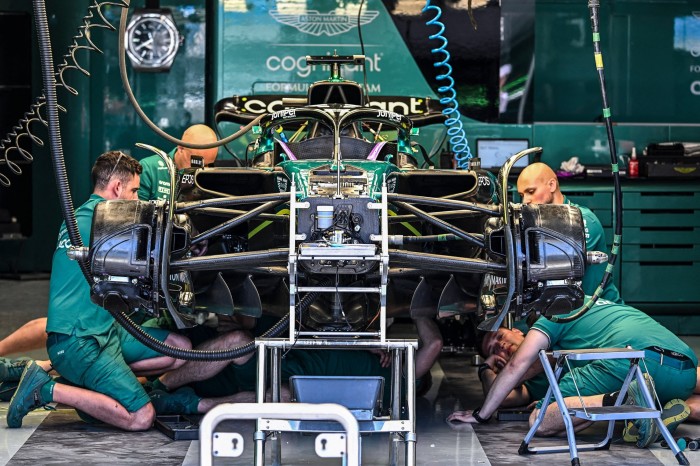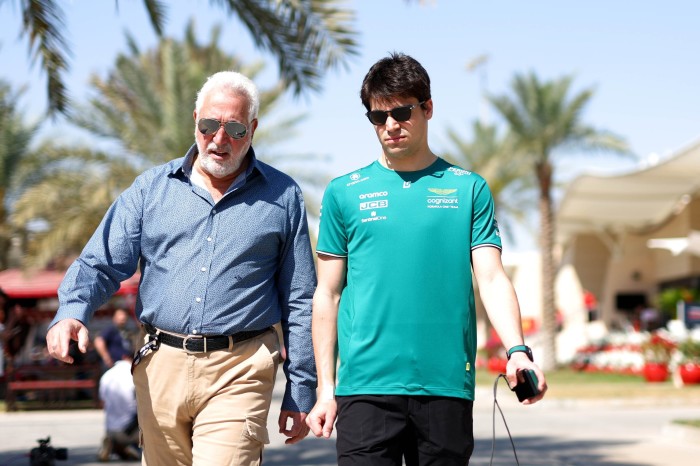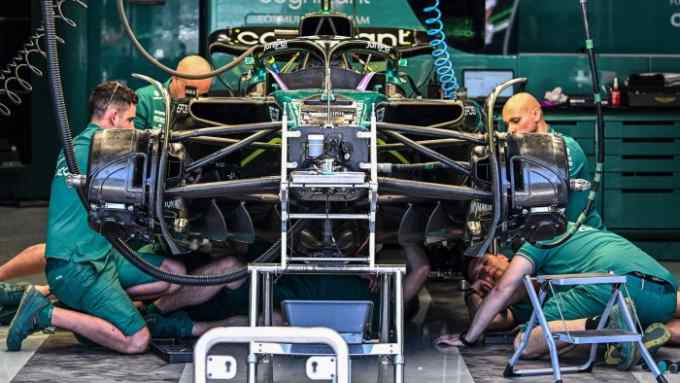F1 team valuations continue to rise

Roula Khalaf, Editor of the FT, selects her favourite stories in this weekly newsletter.
Just over five years ago, Canadian fashion mogul Lawrence Stroll paid £90mn to buy the defunct Force India Formula One racing outfit out of administration — the latest billionaire to be tempted into a sport notorious for its financially unsustainable teams.
Rebranded as Aston Martin F1 since 2021, the team has brought back British racing green to the grid, attracted new sponsors — including Saudi state oil company Aramco — and ridden the resurgence in the sport’s popularity.
Stroll, whose son, Lance, races for the team, has invested heavily in Aston Martin, including the development of a modern headquarters near the Silverstone circuit that hosts the British Grand Prix.
Then, last week, on the eve of the first Las Vegas Grand Prix in four decades, he sold a minority stake to US investment house Arctos Partners at a valuation north of £1bn.
The Arctos deal is just the latest to suggest that F1 teams are shedding their ‘trophy asset’ reputation, which led many to consider them the fastest way to turn a billion-dollar fortune into mere millions.

And a big factor in the higher valuations is a series of structural changes put in place by John Malone’s Liberty Media, which bought F1 in an $8bn deal almost seven years ago.
New financial regulations limit how much teams can spend on developing their cars, and the sport is experiencing a jump in popularity, thanks to social media, expansion into the US, and the Netflix Drive to Survive reality series.
Now that spending is limited, scarcity value also comes into play. There are only 10 teams on the grid, versus 32 NFL franchises, 20 Premier League football clubs, and 30 NBA teams.
Real transactions back up the belief that valuations are rising, as investors continue to pour money into the sport, as they do with other sports. However, F1 teams still lag behind the franchises in American leagues, in terms of both revenues and valuation multiples.
“These franchises should be traded on franchise multiples like US sports,” says Jefferson Slack, managing director for commercial and marketing at Aston Martin.
“There’s no promotion or relegation in F1,” he says. “The sport is in tremendous health. It has cracked the US market, and a lot of institutional capital is coming into sports in a big way: it’s a good space to be in.”
The budget cap was set at $145mn when it was implemented in 2021, and has decreased every year since.
The idea was not only to promote financial sustainability but also to ensure that championships were won on how well money is spent, rather than how much is being thrown at car development. Even so, many teams are still struggling to catch up with Red Bull’s Max Verstappen, who has now won the driver’s championship for the third year running.
As a result, despite the buzz around the sport’s expansion into the US, F1 has not treated its new American fans to a title race this season. Verstappen has ensured that the winners have been a foregone conclusion for much of the season, albeit tempered by close racing in the midfield.
Theo Ajadi, a manager within consultancy Deloitte’s Sports Business Group, says the key risk is probably revenue growth around media rights, events and sponsorship. “That may not hold true,” he adds, “if the market moves in a different direction, if F1 isn’t able to capitalise, or if F1 becomes very uncompetitive and viewers turn off.”
According to Forbes’ estimates, the average F1 team was worth about $500mn in 2019, before the spending limits came into force. These days, Forbes values the average team at about $1.9bn.
Recent deals reflect the shift. In August 2020, before the spending limits came into play, US investment group Dorilton acquired the Williams team in a €152mn deal. In December that year, McLaren Racing sold a stake to MSP Sports Capital and other investors at a valuation of £560mn. And, in a deal that completed in January 2022, Sir Jim Ratcliffe’s Ineos agreed to buy a third of the Mercedes F1 team — Companies House filings reveal that Ineos paid £208mn for the stake.
Then, this year, RedBird Capital Partners and other investors, including spin-off Otro Capital, acquired a 24 per cent stake in Alpine for €200mn. The deal valued the Enstone-based team at $900mn.
“It used to be a no-fly zone for us,” says one investor. “F1 teams used to lose a tonne of money prior to the cost cap.”

Toto Wolff, who owns another third of Mercedes F1, says the bigger teams are already starting to move to profitability, with others potentially set to follow suit.
“It is not a trophy investment any more,” Wolff tells the Financial Times. “There is economic and financial rationale for sponsors, investors and team owners because, otherwise, people wouldn’t do that just for fun.”
Mercedes paid dividends of £55mn in 2022, as annual net profit rose to £89mn from £68mn the year before, on revenues up to £474mn from £383mn — although several other teams remain lossmaking.
Under Liberty Media, more money is being shared with the teams, though.
In the first nine months of the year, F1 directed $888mn in total to the teams, up from $838mn in the corresponding period a year earlier. The teams received more than $1.1bn in 2022 as a whole, up from $919mn in 2017, which was Liberty’s first year of ownership. The debate, now, is whether to expand.
The Federation Internationale de l’Automobile (FIA), which governs motorsport, has agreed to let Michael Andretti add a team to the grid.
However, the reception for the Italian-American has been lukewarm so far. Existing participants fear that Andretti’s outfit would eat into the prize money paid out by F1 to the teams. Others argue that the addition of a US team would increase revenue for all. Under the Concorde Agreement — the contract between the FIA, F1 and the teams — any new participant must pay a $200mn fee as the price of diluting the pot. But the sport’s growing popularity has shifted the conversation towards increasing that sum to about $600mn.
The true cost to a new entrant is higher, because of the need to invest in a factory, equipment, development and recruitment. Many teams also fear the consequences of sharing the F1 prize pot across 11 rather than 10 — and a one-off fee is not enough to compensate.
“Two hundred million dollars is like giving money away,” the shareholder says.

Comments